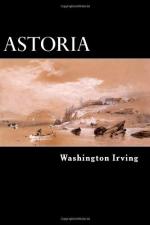The fur countries, from the Pacific, east to the Rocky Mountains, are now occupied (exclusive of private combinations and individual trappers and traders) by the Russians; and on the northwest from Behring’s Strait to Queen Charlotte’s Island, in north latitude fifty-three degrees, and by the Hudson’s Bay Company thence, south of the Columbia River; while Ashley’s company, and that under Captain Bonneville, take the remainder of the region to California. Indeed, the whole compass from the Mississippi to the Pacific Ocean is traversed in every direction. The mountains and forests, from the Arctic Sea to the Gulf of Mexico, are threaded through every maze, by the hunter. Every river and tributary stream, from the Columbia to the mouth of the Rio del Norte, and from the M’Kenzie to the Colorado of the West, from their head springs to their junction, are searched and trapped for beaver. Almost all the American furs, which do not belong to the Hudson’s Bay Company, find their way to New York, and are either distributed thence for home consumption, or sent to foreign markets.
The Hudson’s Bay Company ship their furs from their factories of York Fort and from Moose River, on Hudson’s Bay; their collection from Grand River, &c., they ship from Canada; and the collection from Columbia goes to London. None of their furs come to the United States, except through the London market.
The export trade of furs from the United States is chiefly to London. Some quantities have been sent to Canton, and some few to Hamburg; and an increasing export trade in beaver, otter, nutria, and vicunia wool, prepared for the hatter’s use, is carried on in Mexico. Some furs are exported from Baltimore, Philadelphia, and Boston; but the principal shipments from the United States are from New York to London, from whence they are sent to Leipsic, a well-known mart for furs, where they are disposed of during the great fair in that city, and distributed to every part of the continent.
The United States import from South America, nutria, vicunia, chinchilla, and a few deer-skins; also fur seals from the Lobos Islands, off the river Plate. A quantity of beaver, otter, &c., are brought annually from Santa Fe. Dressed furs for edgings, linings, caps, muffs, &c., such as squirrel, genet, fitch-skins, and blue rabbit, are received from the north of Europe; also cony and hare’s fur; but the largest importations are from London, where is concentrated nearly the whole of the North American fur trade.
Such is the present state of the fur trade, by which it will appear that the extended sway of the Hudson’s Bay Company, and the monopoly of the region of which Astoria was the key, has operated to turn the main current of this opulent trade into the coffers of Great Britain, and to render London the emporium instead of New York, as Mr. Astor had intended.
We will subjoin a few observations on the animals sought after in this traffic, extracted from the same intelligent source with the preceding remarks.




